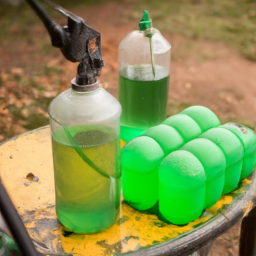How To Fill Paintball Tank At Home
Table of Contents []
- How To Fill A Paintball Tank At Home
- CO2 vs Compressed Air: Key Pros and Cons
- Resources and Refilling
- Safety First
- Refilling Your Tank at Home
- Maintenance and Cleanliness
- Paint Balll Gun C02 Capacity
- Insights
How To Fill A Paintball Tank At Home
Filling a Paintball Tank at Home: Exploring the Essential Perspectives
Whether you're experienced with paintball guns or just now beginning your journey, understanding the basics of filling a paintball tank at home is essential for a successful longterm experience. Understandably, the complexities of this task can be intimidating - and can create potential risks if not discussed and practiced in a responsible manner. To equip you with the proper knowledge, this article seeks to delve into eight pivotal themes surrounding this process.
CO2 vs Compressed Air: Key Pros and Cons
When filling a paintball tank at home, an age-old question arises: do you fill it with CO2 or with compressed air? To begin, it's important to understand that each of these options feature different pros and cons. On the plus side, CO2 tanks are often cheaper and lighter in weight and may even be refilled at a lower cost than compressed air tanks. However, CO2 tanks are susceptible to temperature changes, making them unreliable in cold temperatures. Compressed air tanks, on the other hand, are much pricier and heavier but perform reliably in low temperatures.
Temperature's Impact on Velocity
One of the key consequences of utilizing CO2 in a paintball tank is the significant impact on velocity - as it has been reported that CO2 may reduce a gun's velocity by up to 70 fps (feet-per-second). This is largely attributed to the cooling effect of expansion of the CO2 in the gun's valve resulting in a reduction of pressure and, consequentially, a decrease in velocity. In regards to the compressed air tanks, this is not a relevant issue.
Buying a CO2 Tank
If you've opted to purchase a CO2 tank, here are a few important tips to consider: First, make sure that your purchase includes a cartridges without it, you won't be able to fill your tank. Additionally, be prepared to pay a deposit of up to $40 as most stores require this for tanks less than five years old. Finally, make sure that your tank has been tested and approved by the Department of Transportation otherwise, you won't be able to use it.
Resources and Refilling
Depending on your location, a major component to consider when filling a paintball tank at home is the availability of CO2 and compressed air resources. Most gas and fire extinguisher companies often list refilling services for paintball tanks. Alternatively, some sporting goods store such as Dicks offer a tank exchange service that charge roughly $5 per refill. When in doubt, check to see if your local paintball shop offers any affordable refilling options.
Safety First
Before filling a paintball tank at home, it's important to fully understand and review proper safety protocols. First and foremost, when handling compressed air tanks, make sure to never exceed 3000 psi as tanks with capacity of greater than 3000 are illegal in many states. And when storing your compressed air tank, make sure to avoid temperatures exceeding 140 degrees.
Refilling Your Tank at Home
If safety protocols are followed in a responsible manner, refilling your paintball tank at home may not be as daunting as it initially seemed. Investing in a tank fill adapter, a tank valve, and an adjustable regulator will suit you with the equipment necessary for the successful completion of this task. Additionally, a CO2 gas is ideal for refilling your tank as compared to compressed air.
Maintenance and Cleanliness
Alongside safety protocols, it's important to stay ever mindful of the need for consistent maintenance and cleanliness when handling paintball tanks. According to many experts, it's recommended to clean the threads and O-ring of your tank before each fill. Additionally, wipe down the outside of your tank to remove dirt and debris. Lastly, remove your valve assembly numerous times per year and clean it vigilantly as it is most prone to O-ring damage.
Paint Balll Gun C02 Capacity
It's also advisable to consider the size of your tank in comparison to your paintball gun's C02 capacity. On the one hand, older guns may feature less efficient design and therefore require larger tanks to fire all the way through. Newer guns, however, such as the latest Tippmann models, feature superior design and only require smaller tanks.
Insights
The process of filling a paintball tank at home is deeply rooted in several complex elements. While unpredictable risks may appear prominent, careful consideration of the topics discussed in this article may ensure a rewarding experience. Ultimately, by understanding the pros and cons of CO2 vs Compressed Air, understanding applicable safety protocols, and addressing tank and gun capacities, you'll be well-prepared for your upcoming home-filling project.

Previous Page
Next Page
